

Japan and the Limits of Military Power - NYTimes.com. Prime Minister Shinzo Abe has disturbed many in Japan and increased anxiety in Asia by reinterpreting his country’s pacifist postwar Constitution so that the military can play a more assertive role than it has since World War II.
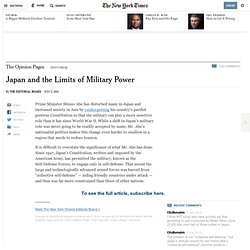
While a shift in Japan’s military role was never going to be readily accepted by many, Mr. Abe’s nationalist politics makes this change even harder to swallow in a region that needs to reduce tension. Sites of Japan's Meiji Industrial Revolution: Kyushu-Yamaguchi and Related Areas. Spirit of Manufacturing This is a unique story of how a small isolated Asian nation, without modern western technology, made enormous strides in terms of economic growth and modernization in just half a century.
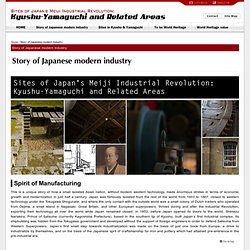
Japan was famously isolated from the rest of the world from 1603 to 1867, closed to western technology under the Tokugawa Shogunate, and where the only contact with the outside world was a small colony of Dutch traders who operated from Dejima, a small island in Nagasaki. Great Britain, and other European superpowers, thrived during and after the Industrial Revolution, exporting their technology all over the world while Japan remained closed. In 1852, before Japan opened its doors to the world, Shimazu Nariakira, Prince of Satsuma (currently Kagoshima Prefecture), based in the southern tip of Kyushu, built Japan’s first industrial complex. Coal Mining Built the City Coal was called “the black diamond” at the end of the Edo period.
JAPANESE TEA CEREMONY. Japanese Tea Ceremony - Japanese Tea Ceremony History - Japanese Tea Ceremony Pictures - Japanese Tea Ceremony Types The Japanese tea ceremony (cha-no-yu, chado, or sado) is a traditional ritual influenced by Zen Buddhism in which powdered green tea, or matcha (抹茶), is ceremonially prepared by a skilled practitioner and served to a small group of guests in a tranquil setting.

Japanese Tea Ceremony Cha-no-yu (茶の湯, literally "hot water for tea"), usually refers to a single ceremony or ritual, while sado or chado (茶道, or "the way of tea") refer to the study or doctrine of tea ceremony. Since a tea practitioner must be familiar with the production and types of tea, with kimono, calligraphy, flower arranging, ceramics, incense and a wide range of other disciplines and traditional arts in addition to his or her school's tea practices, the study of tea ceremony takes many years and often lasts a lifetime.
JAPANESE NEW YEAR - NEW YEAR IN JAPAN. Japanese New Year is very much a family event.

JAPANESE CASTLES. Japanese Castles - Guide to over 130 Japanese Castles including history, design, architecture, Japanese Castle pictures and interactive map.
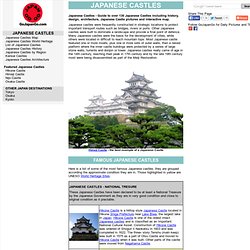
Japanese castles were frequently constructed in strategic locations to protect important transport routes such as bridges, rivers or ports. Other Japanese castles were built to dominate a landscape and provide a final point of defence. Many Japanese castles were the basis for the development of cities, while others were located in difficult to reach mountain tops. Most Japanese castle featured one or more moats, plus one or more sets of outer walls, then a raised platform where the inner castle buildings were protected by a series of large stone walls, turrents and donjon or tower. Japanese castles really came of age in the 14th century, reaching their peak in 17th century and by the late 19th century most were being disassembled as part of the Meiji Restoration. The Meiji cultural revolution. Written by Maciamo on 14 March 2004 (slightly revised in January 2012) Historical background In the mid 19th century, Japan was a country closed to the Western world (with the notable exceptions of the Dutch trading post in Nagasaki) and had been so for about two and half centuries.
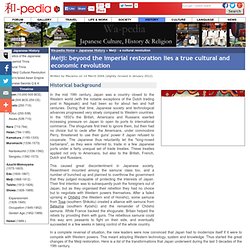
During that time, Japanese society and technological advances progressed very slowly compared to Western countries. In the 1850's the British, Americans and Russians exerted increasing pressure on Japan to open its ports to international commerce. The shogunate first tried to ignore them, but then had no choice but to cede after the Americans, under commodore Perry, threatened to use their guns' power if Japan refused to cooperate.
Imperial Japan. When Emperor Hirohito ascended to the throne in 1926, Japan was enveloped in a struggle between liberals and leftists on one side, and ultraconservatives on the other.
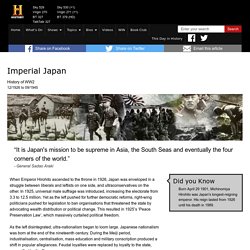
In 1925, universal male suffrage was introduced, increasing the electorate from 3.3 to 12.5 million. Yet as the left pushed for further democratic reforms, right-wing politicians pushed for legislation to ban organisations that threatened the state by advocating wealth distribution or political change. This resulted in 1925’s ‘Peace Preservation Law’, which massively curtailed political freedom. As the left disintegrated, ultra-nationalism began to loom large. Japanese nationalism was born at the end of the nineteenth century. Although early ultra-nationalists called for a tempering of Japan’s ‘westernisation’, through limits on industrialisation, their focus changed after the First World War.
Japan Futures Drop After Apple Falls; Dollar Holds Gains. Japanese and Australian index futures dropped as the Standard & Poor’s 500 Index fell the most in a month and Apple (AAPL) Inc. retreated after unveiling new products.
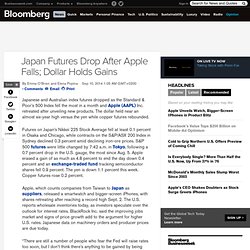
The dollar held near an almost six-year high versus the yen while copper futures rebounded. Futures on Japan’s Nikkei 225 Stock Average fell at least 0.1 percent in Osaka and Chicago, while contracts on the S&P/ASX 200 Index in Sydney declined 0.3 percent amid declining iron-ore prices. S&P 500 futures were little changed by 7:42 a.m. in Tokyo, following a 0.7 percent drop in the U.S. gauge, the most since Aug. 5. Apple erased a gain of as much as 4.8 percent to end the day down 0.4 percent and an exchange-traded fund tracking semiconductor shares fell 0.9 percent. The yen is down 1.1 percent this week.
Apple, which counts companies from Taiwan to Japan as suppliers, released a smartwatch and bigger-screen iPhones, with shares retreating after reaching a record high Sept. 2. Treasury Auctions.